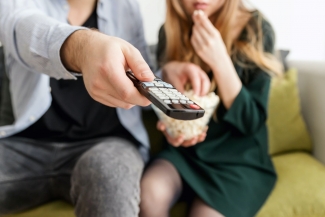The Best Eye-Friendly TV Series
The Best Binge-Worthy TV Shows for Good Eye Health
It’s no secret that we’re a nation of TV watchers. In 2020, the average adult spent almost four hours a day watching TV, a guilty habit no doubt exacerbated by ongoing lockdowns and more time spent at home. In fact, according to Ofcom, on average, Britons spent a third of their waking hours watching TV and online videos in 2020.
As much as we all love binge-watching the latest Netflix release, this level of screen exposure has the potential to wreak havoc on our eyes, but there are ways we can keep watching our favourite shows whilst mitigating the risk.
Let’s face it, our TV consumption is only going to increase, so by paying attention to things like colour scale, light and picture formats, we can adjust our exposure accordingly and continue to tune in whilst protecting the very thing we need to be able to engage.
In light of this, we’ve analysed some of the UK’s favourite TV shows to score them on how eye-friendly their colour palettes are. We’ve also explored what to look out for if you want to give your eyes an easier ride, and how to watch your favourite programmes safely and healthily.
How eye-friendly are your favourite TV shows?
We all love a good binge-watch of our favourite TV show or the latest series, but did you know, some programmes are more eye-friendly than others, thanks to their colour palettes.
We’ve taken seven popular TV series, and looked at how easy on the eyes their colour palettes are, giving them a score from 0 (worst for our eyesight) to 600 (best for our eyesight). Colours towards the middle of the colour spectrum, like orange, yellow, and even some shades of red, tend to be easier on the eye, and therefore have a higher score. Conversely, violet is to the far left of the colour spectrum, which means a greater chance of strain on the eye and consequently eye fatigue, therefore giving it a low score.
Have a look at some of the shows below and see what scores they get – some are more surprising than others. Or, why not try it for yourself and see how your favourite series fares?
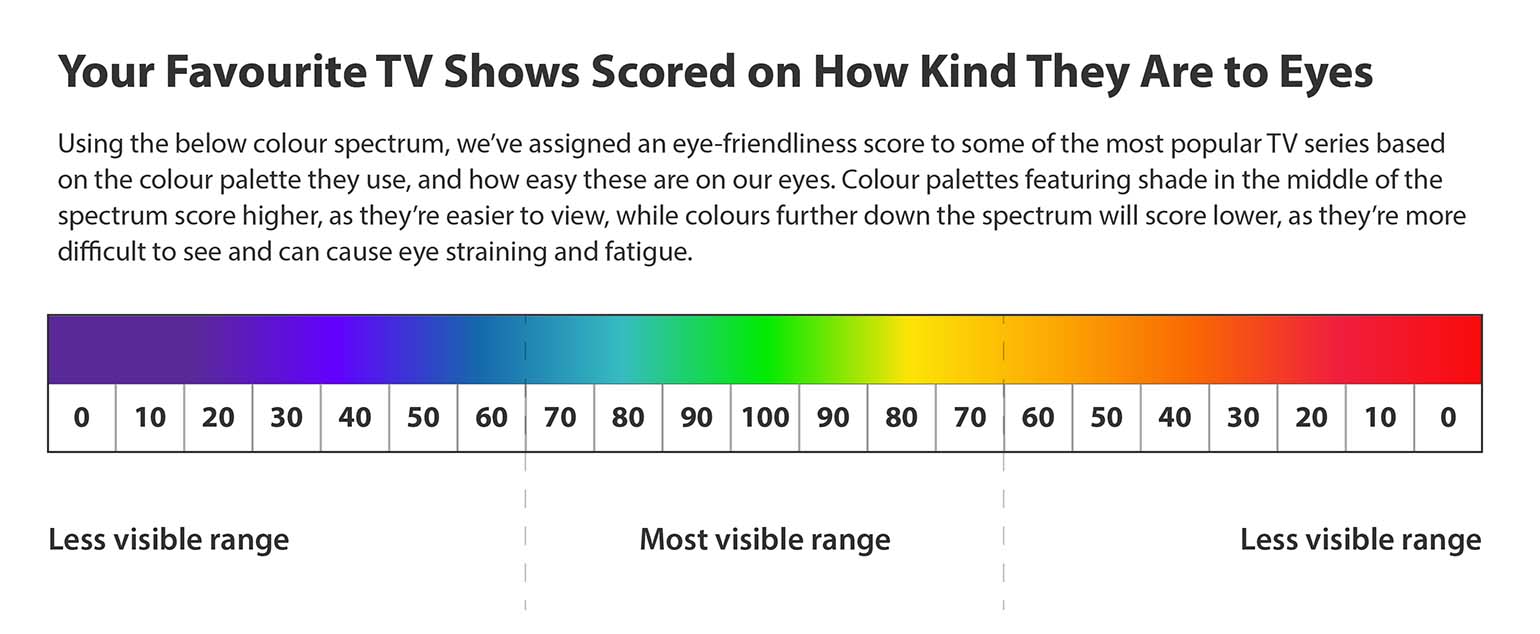
Britain’s Favourite TV Shows and Their Effect on Your Eyesight
We’ve examined seven of the UK’s most popular TV shows across genres, looking into how eye-friendly each of them is based on the colour palettes they use. Each have then been given a score from 0-600, from the least, to the easiest on the eyes.
Sex Education
Popular drama Sex Education has a highly saturated and slightly unusual colour palette, likely in part due to it being inspired by the 70s. Seasons one and two were filmed in the summer, with emphasis placed on natural red and green shades. Our eyes see green with ease due to its place in the middle of the colour spectrum, with some scientists believing that the shade may calm us down too, making for a more relaxing viewing experience. This is because our eyes are at the peak of their perception to detect the wavelengths corresponding with the colour green.
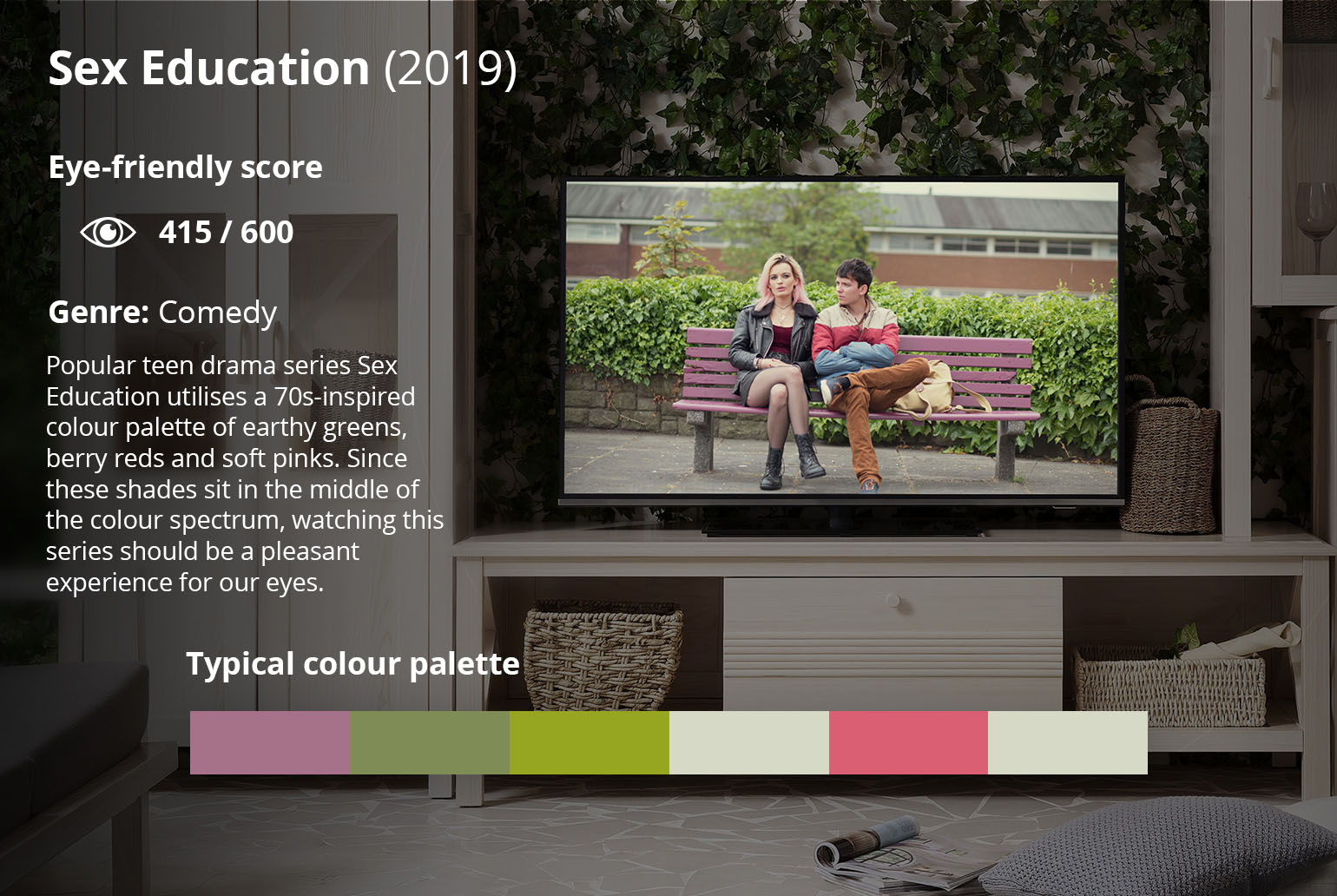
The Simpsons
A timeless classic for both kids and adults alike, cartoon The Simpsons features a lot less nuance in its colour palette and can therefore be a trickier show to watch for extended periods of time. Bright yellow - the most fatiguing colour to our eyes - is heavily featured, so if you find yourself feeling a little visually strained after a few episodes, that may be why. Despite this, it is also the easiest colour to see, allowing the colourful characters to stand out on your screen.
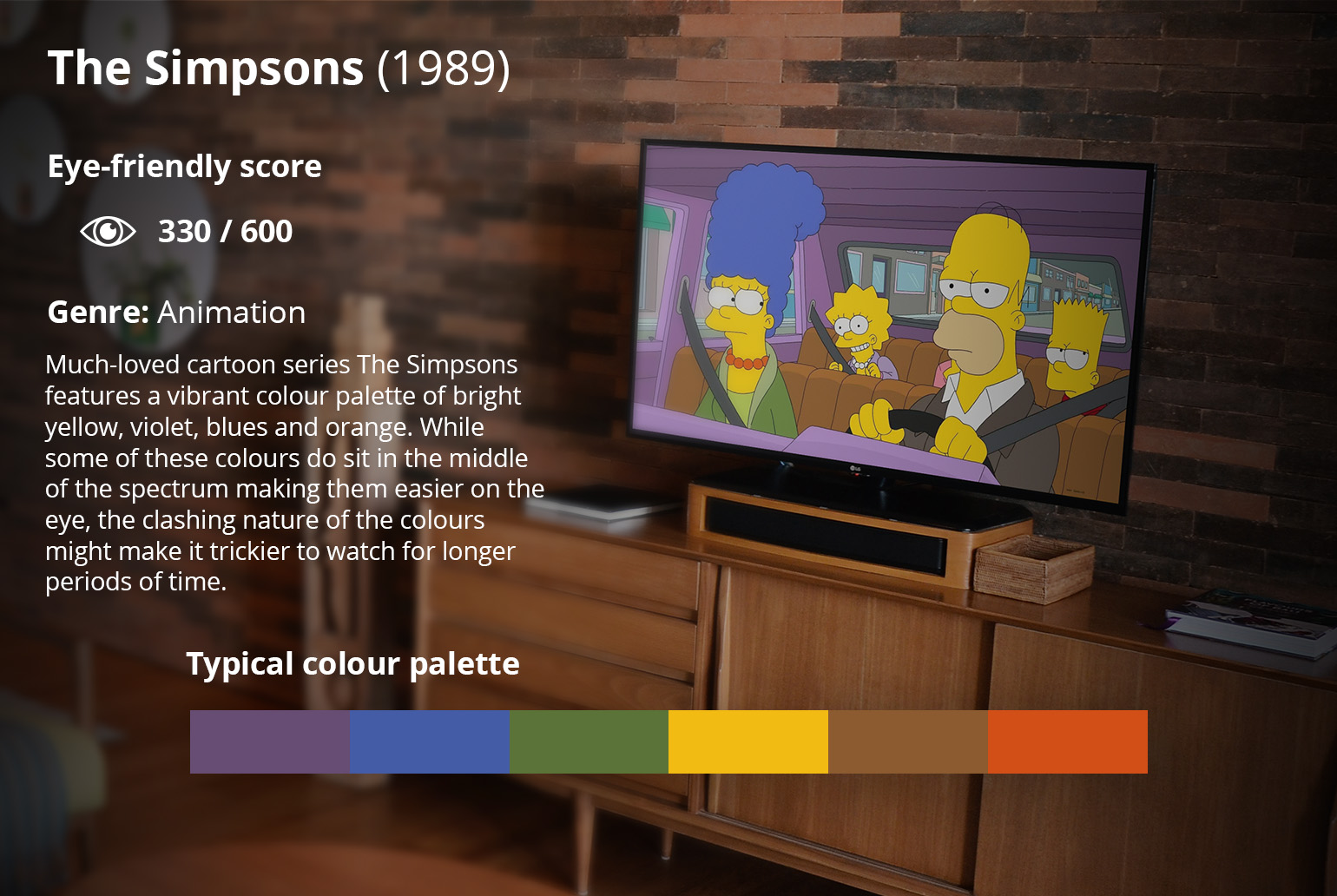
Bridgerton
The cinematographers for one of 2020’s biggest Netflix hits, Bridgerton, used low-light cinematography to ensure that the rich and romantic tones of colours used came through without seeming artificial to the viewer. The result is a feast for the eyes; soft sky blues, pale lilacs and forest greens that retain their pigmentation whilst still appearing natural. Even the character’s costumes were created to match the settings. The result of these beautiful toned down colours has more of a relaxing effect on the eyes.
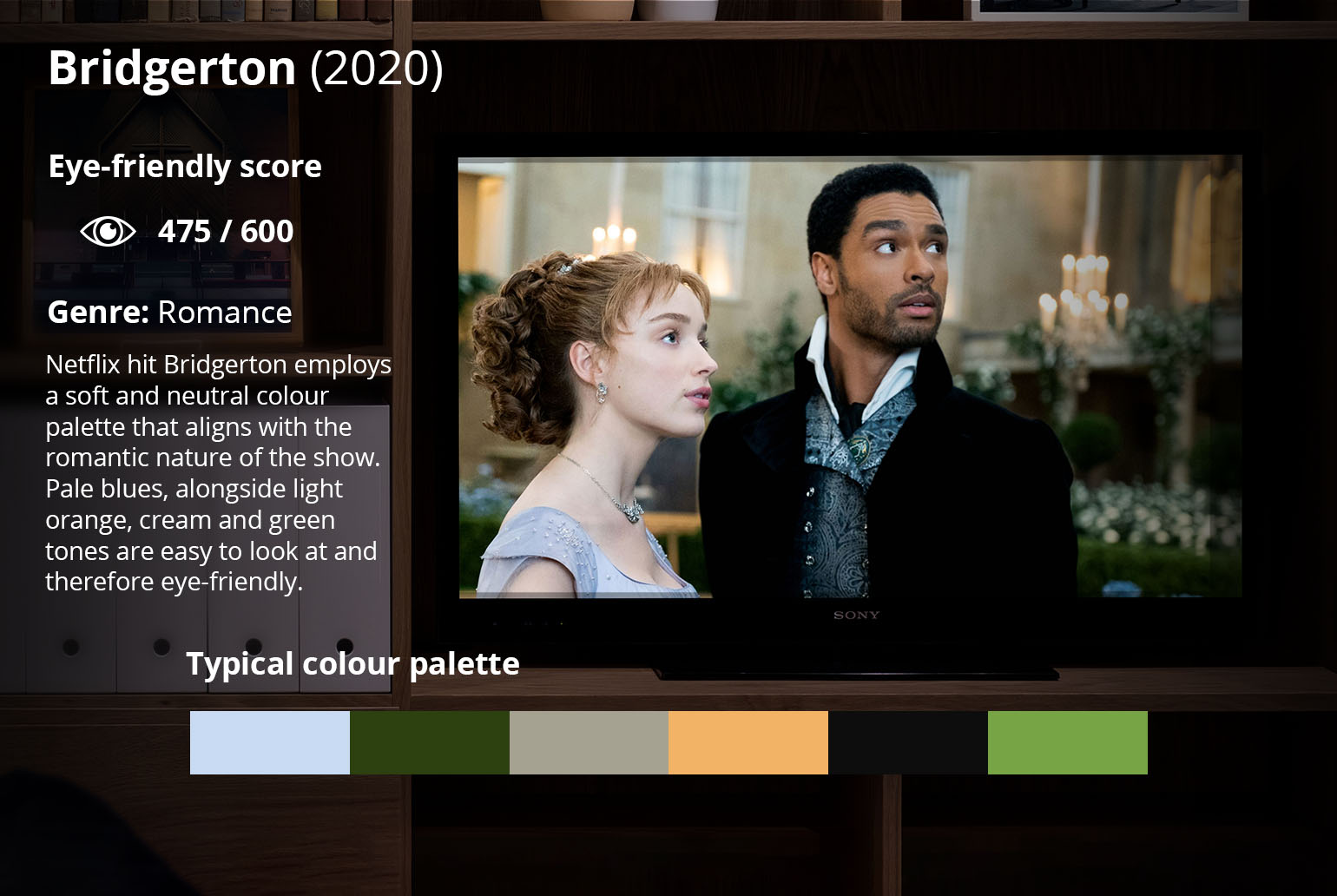
Ru Paul’s Drag Race
Fan favourite Ru Paul’s Drag Race focuses heavily on bright, vivid, combination colours, all of which have an eye-catching effect. However, the flashing lights, dance sequences and range of colours and textures filmed in the show have the potential to cause slight damage to your eyes over extended periods of time. It’s a good job episodes are released on a weekly basis to give your eyes the chance to rest!
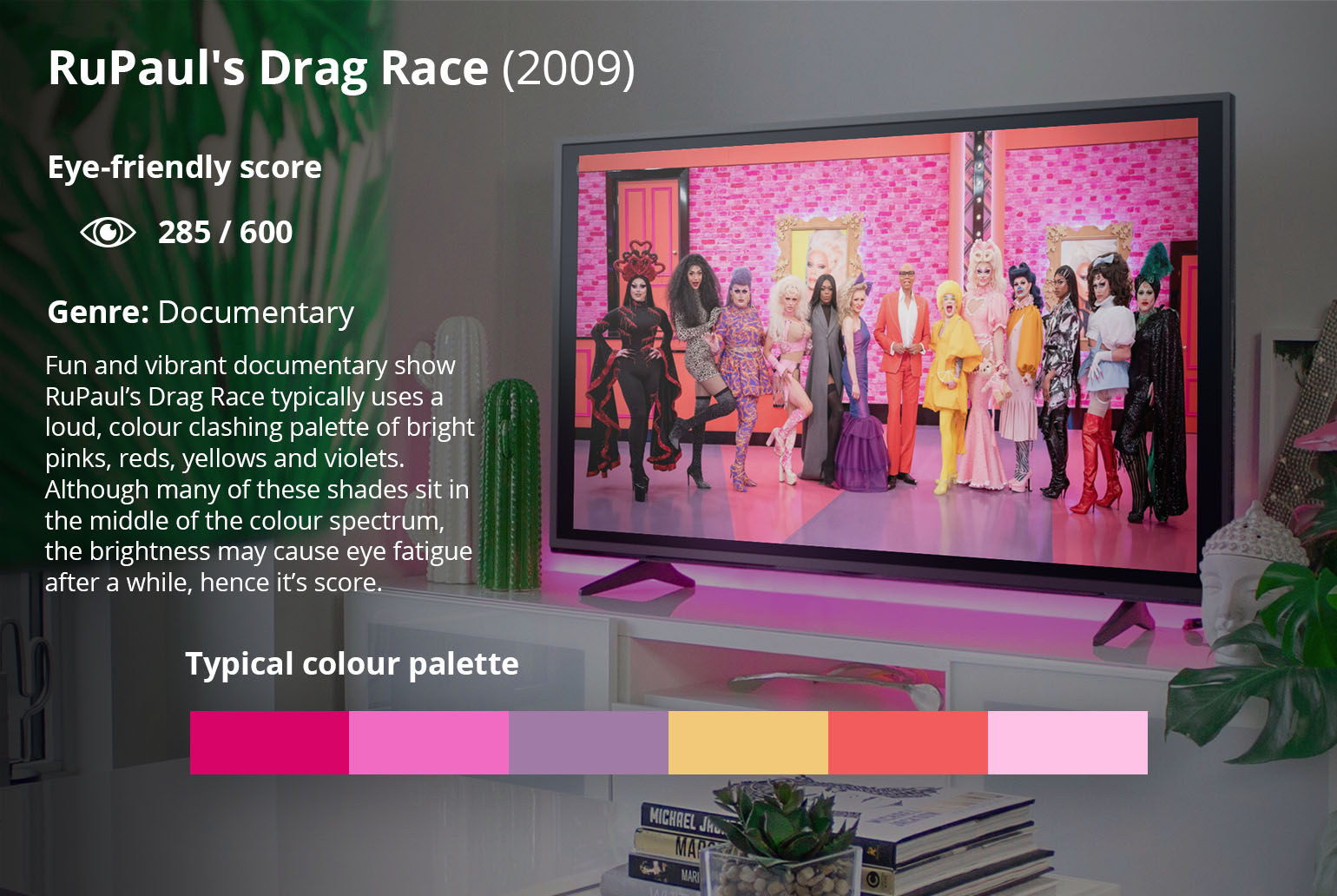
Squid Game
The main shades used in Korean hit Squid Game’s colour palette are clashing pink and green, a visually easy choice which juxtaposes the darker nature of the show’s content. The infamous fight scene in episode 3, however, is almost entirely black and lit only by a flashing strobe light. If viewed over a longer period of time, strobe lighting can have a damaging effect on the eyes, causing them to strain, but this particular use helps to heighten the tension of the scene by creating a disorientating effect.
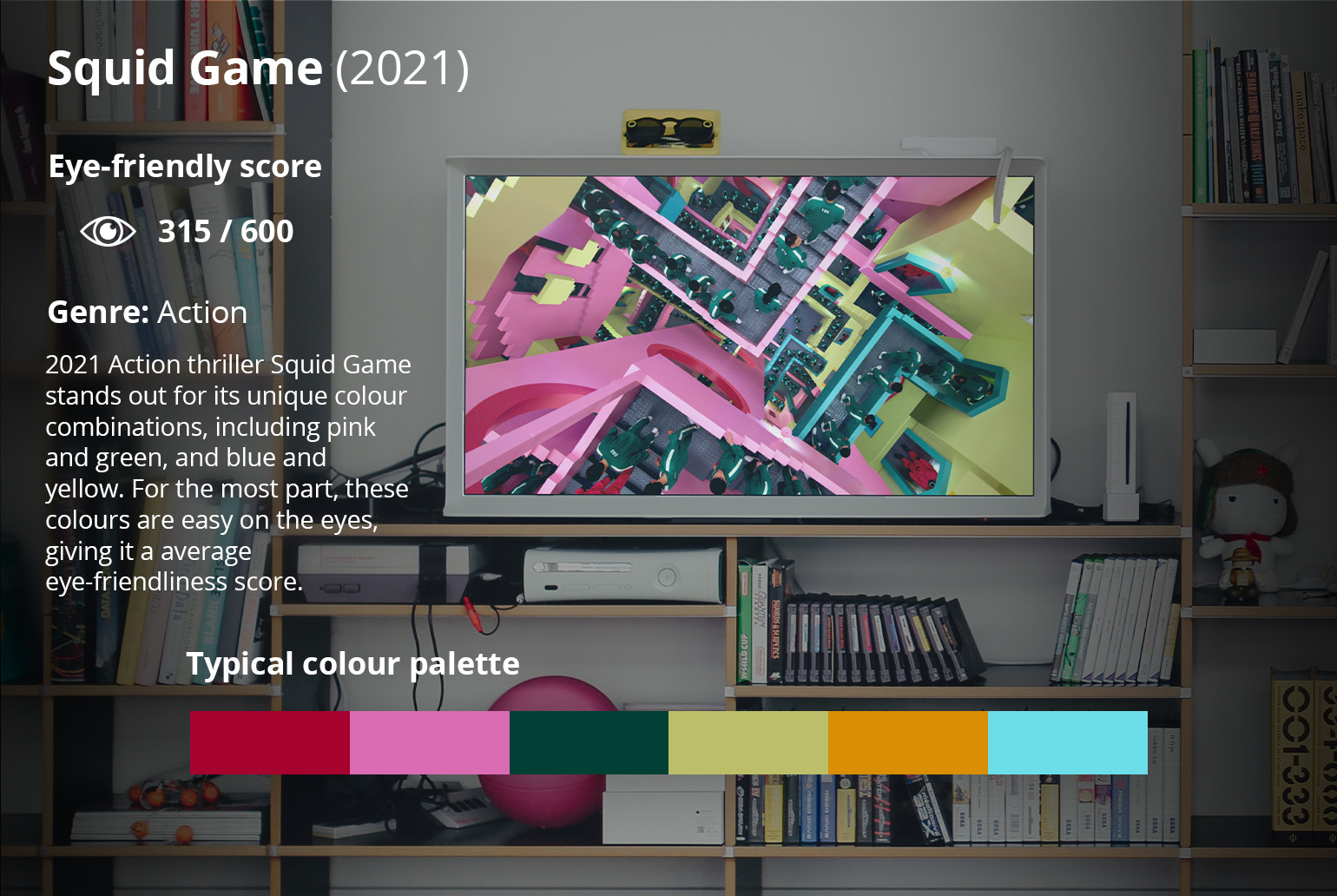
Blue Planet
Blue Planet has a heavily - that’s right, you guessed it - blue-toned colour palette. However, blue is not the only colour featured in David Attenborough’s famous docu-series, which also has greens, browns and neutral tones coming into play. As a nature series, the colours featured are naturally easy on the eyes, as they’re the colours we originally evolved to be able to see in the world around us.
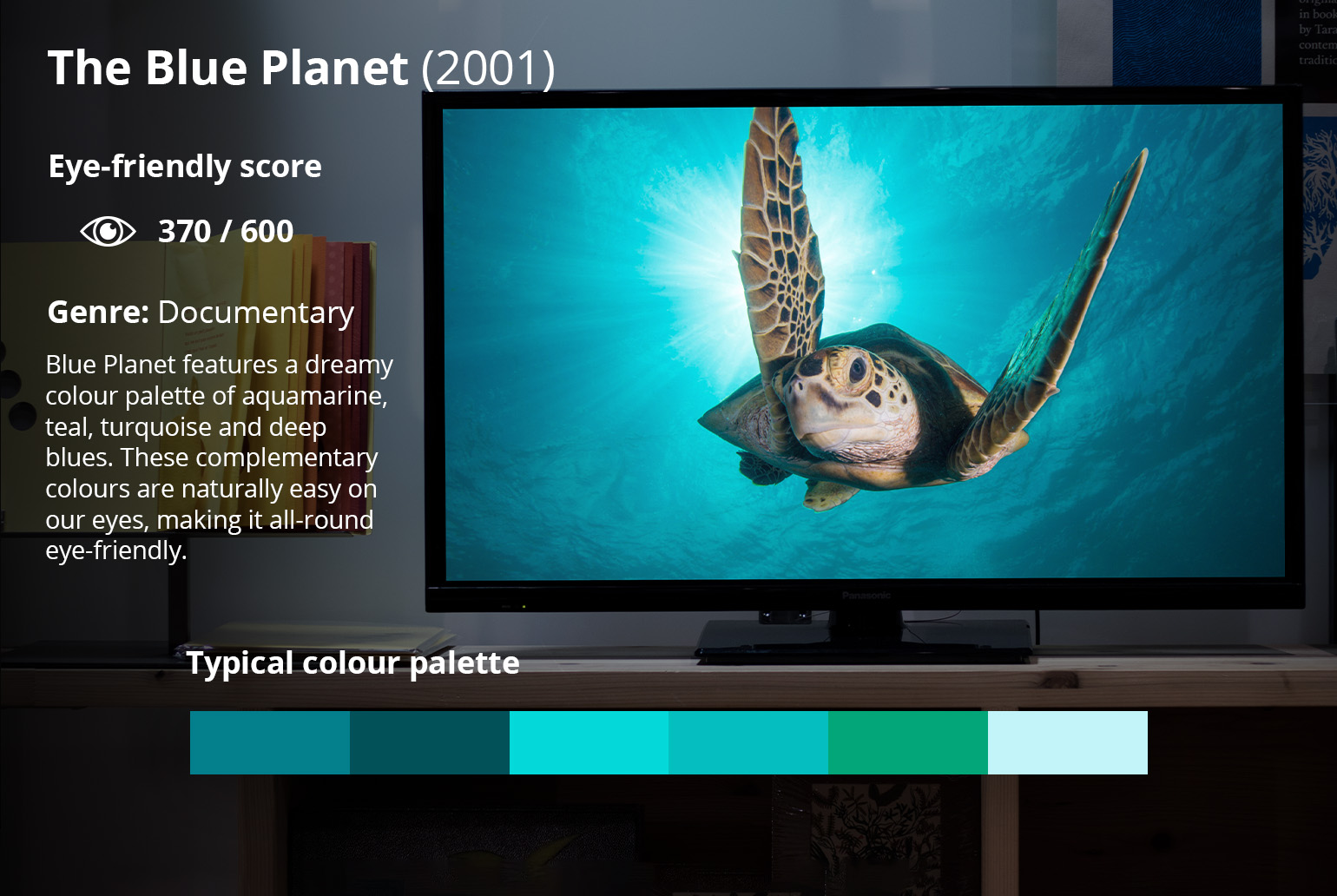
American Horror Story
American Horror Story features a combination of neutral hues, set against a red and black-toned colour palette, reflective of its dark and creepy nature. Despite this, red is actually deemed a safe, almost therapeutic colour for our eyes, and can even be used to treat certain health conditions. According to a study published in Journals of Gerontology, looking into a deep red light for three minutes each day may significantly improve declining eyesight. That being said, it can be difficult for our eyes to distinguish between similar colours on screen, so this has the potential to strain our eyes in the long-term.
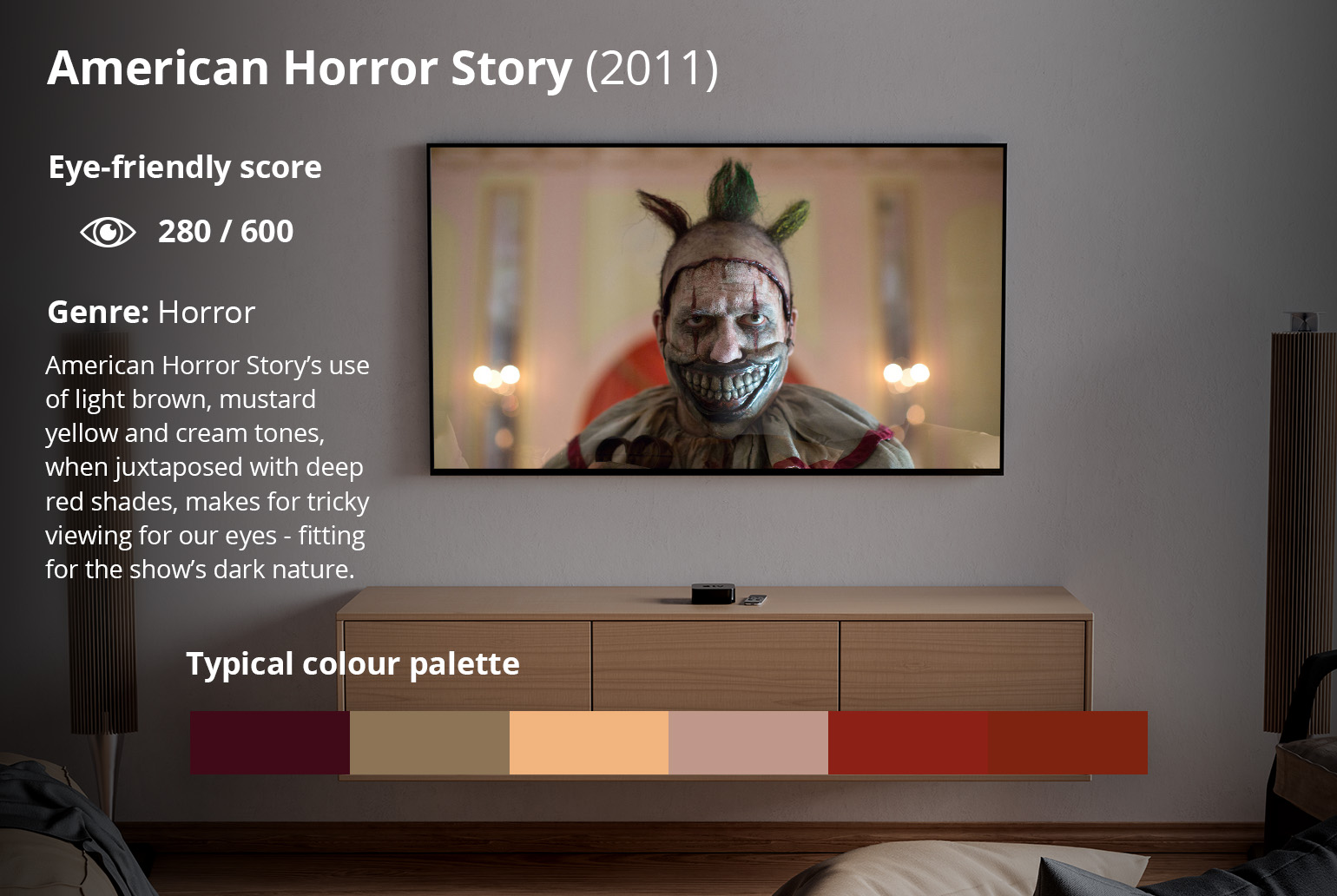
How Does Colour and Lighting Affect Eye Health?
It’s a fact that the human eye has the ability to see some 7,000,000 colours. Our eyes process this information to the brain so quickly that we don’t even notice it. But can different colours and lighting affect our eyesight, or even our moods?
The answer is, yes.
Certain colours can aggravate or irritate our eyes, making them weary or having to strain in order to do simple everyday things like watch television.
Bright yellow in particular is said to be the most fatiguing colour, because more light is reflected by bright colours, making our eyes work harder. Conversely, it’s one of the most visible colours on the spectrum, so can be used to get attention or warn people, which is why it’s commonly used in road signage.
The lights produced by computer or television screens also cause our eye muscles to work harder, with elements such as contrast and glare causing additional stress. Blue lights on screens (from LED backlights) tend to flicker more frequently, which can cause eye fatigue and in some cases retina damage. In fact, the easiest colours to look at on-screen tend to be colours in the middle of the spectrum, including reds, oranges and yellows. Bear in mind though, that bright yellows can also cause eye strain, if looked at for longer periods of time.
It’s unsurprising, then, that our eyes need to adjust accordingly depending on what it is that we’re watching, how long we’re viewing for, and which colours and lighting our eyes are interpreting.
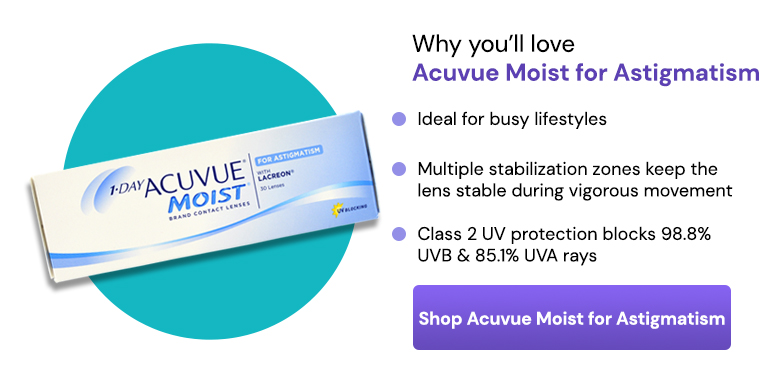
Looking After Your Eyes While Watching TV
With more streaming services available than ever, and more and more of us spending time at home, our TV consumption shows no signs of slowing down. It’s therefore important to ensure you’re taking all necessary steps to protect your eyes from potential strain and damage. Our expert Optometrist Sujata gives the following top tips to keep your eyes ship shape, while still enjoying your favourite programmes:
- Take regular breaks
“Whilst watching television, remember the 20-20 rule. For every 20 minutes of TV screen viewing, take a 20 second break and look away, ideally at something 20 feet or more away. This break will help with eye fatigue and will keep your eye muscles working well.”
- Use the right lighting
Sujata says: “We all like to watch our favourite shows or movies in the dark from time to time for the full cinematic experience. This can, however, put unnecessary strain on our eyes, as our pupils dilate, thus allowing bright light to penetrate easily. You can mitigate this by switching on a small lamp elsewhere in the room whilst you’re watching.”
- Watch from a safe distance
“Large screens such as 40 or 50inch displays can help to prevent eye strain. That being said, the wider the screen, the more space you’ll need between you and the screen to ensure your eyes aren’t straining too much. I’d recommend a distance of about 2-3 metres from a 40 inch TV and 2-3.5 metres from a 50 inch TV.”
- Consider your TV placement
Did you know that a sore neck can lead to eye strain? Sujata recommends placing your TV at eye level to avoid straining your neck from looking up.
- Try TV glasses
As recommended by our expert Sujata, giving your eyes a break from lenses and wearing TV glasses can improve your visual comfort during long periods of screen time.
How to Spot If You Have an Eye Condition While Watching TV
We all feel the odd discomfort in our eyes every now and again, but how do you know when your TV watching habits might be causing you to develop an eye condition? Sujata recommends looking out for the following:
- Headaches and eye fatigue
Whilst TV isn’t permanently damaging to your eyesight, if you start to experience headaches, eye strain and eye fatigue, you may have developed an eye condition. Be sure to see your doctor to rule anything out, and ensure you take regular breaks, and rest your eyes after a lengthy viewing session.
- Sore, burning, itchy or watery eyes
Again, if you’ve been spending a lot of time in front of your screen and you begin to develop physical symptoms including sore, burning or itchy eyes, you could have an eye condition. If this happens, be sure to book an appointment with your doctor or optometrist.
- Blurred vision
In addition to over-exposure to your TV, blurred vision may be a sign of a vision-related condition, such as long or short-sightedness or astigmatism. Astigmatism occurs when either the front surface of the eye (cornea) or the lens inside the eye has a mismatched curve, and causes blurry and distorted vision for both near and far distances.
In an eye with astigmatism, light focuses on several points instead of just one, which causes an object to appear unclear and blurry where the edge of an object is undefined, thus giving it a soft-focus effect. This can make watching TV quite a strain, but can be easily fixed with toric lenses, which are specifically designed to correct these effects.
If you’re worried about any discomfort you may be experiencing whilst watching TV, book an appointment with one of our specialists, who will be able to provide bespoke advice specific to you.
Whether you’re a serial binge-watcher or a devout weekly episode follower, your eyes have the potential to respond to the lights and colours used in your favourite shows in a myriad of different ways. Glasses wearers, lens wearers and those with astigmatism who use toric lenses, can all benefit from viewing a wide range of colour palettes. Just make sure you go for regular eye check-ups and avoid overexposing your eyes to too much screen time. After all, your eyes are one of your best assets, so it’s worth taking good care of them.
Contact us to learn more about how to improve your eye health.



